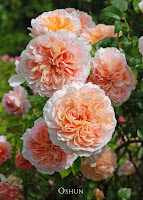
Above: 'Baby Austin', 2001. A second generation
R. soulieana hybrid rarely exceeding 10" tall.
On September 14, 2009, at 102 years of age, Ralph S. Moore passed away. I doubt there is anyone reading this blog today who does not know that Ralph was a pioneer, an innovator whose influence on modern rose breeding has been global. Many modern roses have Moore rose genes in their pedigree, and for good reason: Ralph's roses are easy to grow, prolific with bloom and have great genetic diversity. Moore roses are often also very easily propagated; something Ralph regarded as very important for the future of the modern nurseryman. There are so many things Ralph gave us that we should be thankful for.
Some years ago Carolyn Supinger, Ralph's nursery/office manager, shared with me a stack of Ralph Moore's writings that had been archived in the office for many years. Carolyn knew that I had an interest in playing the role of unofficial "biographer" for Mr. Moore and so she arranged for me to have copies of most of the written materials from the office. Among the stacks of paper we found there, one article in particular stuck out when I read it: it contained a carefully distilled page that summarized what I have come to think of as the core philosophy of Mr. Moore's work ethic. This brief article reads more like a "note to self" than anything else, which indeed perhaps it was. The following is a direct quote from the first page of the note:
I Believe In Miracles(or Stick Around For Fifty Years and See What Happens)
by Ralph S. Moore
In any endeavor there are four things which contribute to success. These are:
a) Communication
b) Dedication
c) Persistence
d) Vision
A.
Communication: Word of mouth / Directed study / Books, etc. / What the market wants.
LOOK AT YOUR PLANTS: - they can communicate a lot, viz.:
- Water
- Fertilizer, etc. to the breeder
- Small differences / bending the plant the way you want it to go.
- The "Burning Bush" experience. (see explanation below)
B.
Dedication:
- It is being there
- Its is being in it for the long haul
- It is overlooking failures and disappointments
- It is knowing it is all worthwhile
C.
Persistence:
- DON'T take NO for an answer!
- It is finding a way
- It is seeking advice, but not being bound by that advice
- It is "STICK-TO-IT-IVENESS"
D.
Vision: Possibly the most important of all.
- It is seeing things as they might be
- It is sometimes separating that VISION into parts which step by step are attainable
- It is being ready to change course
- It is finding a better way
- It is seeing the whole as though it were already accomplished; a reality.
So you don't believe in miracles? Sequoia Nursery / Moore Miniature Roses have been a miracle....things never seen or done before have happened here. THE ROSE is a miracle. A lot has been accomplished but much more needs to be done. Let us set our sights high....THINK the IMPOSSIBLE DREAM.
*end of quote*
To elaborate on what Ralph often described as
The "Burning Bush" experience, I can add the following: to me, he described this as the experience whereby a person can become so focused on the goals immediately in
front of him that he neglects to look
around him and see what else is happening. If the hybridizer does not look carefully at his results, important and subtle features and shifts might go unnoticed, and so opportunities can be lost. Knowing how and where to proceed can be greatly influenced by recognizing when a new door has opened. This was a very important aspect of Ralph's scientific mind and it kept him alert and watchful all of his life, in all ways.
My personal thanks to you Ralph, for all your many kindnesses and for sharing both your knowledge and your plants in order to further my own breeding goals.
Ralph Moore obituary at The Valley Voice
 I was sorting through my 2009 photo library and ran across this seedling photo (and many others!) I thought worth sharing.
I was sorting through my 2009 photo library and ran across this seedling photo (and many others!) I thought worth sharing.













































